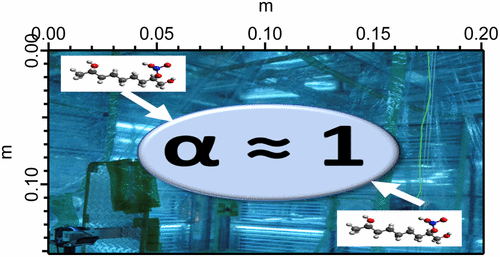当前位置:
X-MOL 学术
›
Environ. Sci. Technol.
›
论文详情
Our official English website, www.x-mol.net, welcomes your
feedback! (Note: you will need to create a separate account there.)
Direct Measurements of Gas/Particle Partitioning and Mass Accommodation Coefficients in Environmental Chambers
Environmental Science & Technology ( IF 10.8 ) Pub Date : 2017-09-18 00:00:00 , DOI: 10.1021/acs.est.7b02144 Jordan E. Krechmer 1 , Douglas A. Day 1 , Paul J. Ziemann 1 , Jose L. Jimenez 1
Environmental Science & Technology ( IF 10.8 ) Pub Date : 2017-09-18 00:00:00 , DOI: 10.1021/acs.est.7b02144 Jordan E. Krechmer 1 , Douglas A. Day 1 , Paul J. Ziemann 1 , Jose L. Jimenez 1
Affiliation

|
Secondary organic aerosols (SOA) are a major contributor to fine particulate mass and wield substantial influences on the Earth’s climate and human health. Despite extensive research in recent years, many of the fundamental processes of SOA formation and evolution remain poorly understood. Most atmospheric aerosol models use gas/particle equilibrium partitioning theory as a default treatment of gas-aerosol transfer, despite questions about potentially large kinetic effects. We have conducted fundamental SOA formation experiments in a Teflon environmental chamber using a novel method. A simple chemical system produces a very fast burst of low-volatility gas-phase products, which are competitively taken up by liquid organic seed particles and Teflon chamber walls. Clear changes in the species time evolution with differing amounts of seed allow us to quantify the particle uptake processes. We reproduce gas- and aerosol-phase observations using a kinetic box model, from which we quantify the aerosol mass accommodation coefficient (α) as 0.7 on average, with values near unity especially for low volatility species. α appears to decrease as volatility increases. α has historically been a very difficult parameter to measure with reported values varying over 3 orders of magnitude. We use the experimentally constrained model to evaluate the correction factor (Φ) needed for chamber SOA mass yields due to losses of vapors to walls as a function of species volatility and particle condensational sink. Φ ranges from 1–4.
中文翻译:

直接测量环境室内的气体/颗粒分配和质量容纳系数
二次有机气溶胶(SOA)是细颗粒物的主要贡献者,并对地球的气候和人类健康产生重大影响。尽管近年来进行了广泛的研究,但对SOA形成和演化的许多基本过程仍知之甚少。尽管对潜在的大动力学影响存在疑问,但大多数大气气溶胶模型都使用气体/颗粒平衡分配理论作为气溶胶转移的默认处理方法。我们已经使用一种新方法在特氟龙环境室内进行了基本的SOA形成实验。简单的化学系统可产生非常快速的低挥发性气相产物,这些产物可竞争地被液态有机种子颗粒和特富龙室壁吸收。物种随着种子数量的不同而随时间变化的明显变化,使我们能够量化颗粒的吸收过程。我们使用动力学盒模型重现气相和气溶胶阶段的观测值,从中我们可以将气溶胶质量容纳系数(α)量化为平均0.7,其值接近于1,特别是对于低挥发性物种。随着波动率的增加,α似乎降低。从历史上看,α一直是一个非常困难的参数,报告值的变化超过3个数量级。我们使用实验约束模型来评估室SOA大量产量所需要的校正因子(Φ),这是由于壁面的蒸气损失与物种挥发性和颗粒凝结沉陷的关系。Φ范围为1-4。我们使用动力学盒模型重现气相和气溶胶阶段的观测值,从中我们可以将气溶胶质量容纳系数(α)量化为平均0.7,其值接近于1,特别是对于低挥发性物种。随着波动率的增加,α似乎降低。从历史上看,α一直是一个非常困难的参数,报告值的变化超过3个数量级。我们使用实验约束模型来评估室SOA大量产量所需要的校正因子(Φ),这是由于壁面的蒸气损失与物种挥发性和颗粒凝结沉陷的关系。Φ范围为1-4。我们使用动力学盒模型重现气相和气溶胶阶段的观测值,从中我们可以将气溶胶质量容纳系数(α)量化为平均0.7,其值接近于1,特别是对于低挥发性物种。随着波动率的增加,α似乎降低。从历史上看,α一直是一个非常困难的参数,报告值的变化超过3个数量级。我们使用实验约束模型来评估室SOA大量产量所需要的校正因子(Φ),这是由于壁面的蒸气损失与物种挥发性和颗粒凝结沉陷的关系。Φ范围为1-4。从历史上看,α一直是一个非常困难的参数,报告值的变化超过3个数量级。我们使用实验约束模型来评估室SOA大量产量所需要的校正因子(Φ),这是由于壁面的蒸气损失与物种挥发性和颗粒凝结沉陷的关系。Φ范围为1-4。从历史上看,α一直是一个非常困难的参数,报告值的变化超过3个数量级。我们使用实验约束模型来评估室SOA大量产量所需要的校正因子(Φ),这是由于壁面的蒸气损失与物种挥发性和颗粒凝结沉陷的关系。Φ范围为1-4。
更新日期:2017-09-18
中文翻译:

直接测量环境室内的气体/颗粒分配和质量容纳系数
二次有机气溶胶(SOA)是细颗粒物的主要贡献者,并对地球的气候和人类健康产生重大影响。尽管近年来进行了广泛的研究,但对SOA形成和演化的许多基本过程仍知之甚少。尽管对潜在的大动力学影响存在疑问,但大多数大气气溶胶模型都使用气体/颗粒平衡分配理论作为气溶胶转移的默认处理方法。我们已经使用一种新方法在特氟龙环境室内进行了基本的SOA形成实验。简单的化学系统可产生非常快速的低挥发性气相产物,这些产物可竞争地被液态有机种子颗粒和特富龙室壁吸收。物种随着种子数量的不同而随时间变化的明显变化,使我们能够量化颗粒的吸收过程。我们使用动力学盒模型重现气相和气溶胶阶段的观测值,从中我们可以将气溶胶质量容纳系数(α)量化为平均0.7,其值接近于1,特别是对于低挥发性物种。随着波动率的增加,α似乎降低。从历史上看,α一直是一个非常困难的参数,报告值的变化超过3个数量级。我们使用实验约束模型来评估室SOA大量产量所需要的校正因子(Φ),这是由于壁面的蒸气损失与物种挥发性和颗粒凝结沉陷的关系。Φ范围为1-4。我们使用动力学盒模型重现气相和气溶胶阶段的观测值,从中我们可以将气溶胶质量容纳系数(α)量化为平均0.7,其值接近于1,特别是对于低挥发性物种。随着波动率的增加,α似乎降低。从历史上看,α一直是一个非常困难的参数,报告值的变化超过3个数量级。我们使用实验约束模型来评估室SOA大量产量所需要的校正因子(Φ),这是由于壁面的蒸气损失与物种挥发性和颗粒凝结沉陷的关系。Φ范围为1-4。我们使用动力学盒模型重现气相和气溶胶阶段的观测值,从中我们可以将气溶胶质量容纳系数(α)量化为平均0.7,其值接近于1,特别是对于低挥发性物种。随着波动率的增加,α似乎降低。从历史上看,α一直是一个非常困难的参数,报告值的变化超过3个数量级。我们使用实验约束模型来评估室SOA大量产量所需要的校正因子(Φ),这是由于壁面的蒸气损失与物种挥发性和颗粒凝结沉陷的关系。Φ范围为1-4。从历史上看,α一直是一个非常困难的参数,报告值的变化超过3个数量级。我们使用实验约束模型来评估室SOA大量产量所需要的校正因子(Φ),这是由于壁面的蒸气损失与物种挥发性和颗粒凝结沉陷的关系。Φ范围为1-4。从历史上看,α一直是一个非常困难的参数,报告值的变化超过3个数量级。我们使用实验约束模型来评估室SOA大量产量所需要的校正因子(Φ),这是由于壁面的蒸气损失与物种挥发性和颗粒凝结沉陷的关系。Φ范围为1-4。











































 京公网安备 11010802027423号
京公网安备 11010802027423号